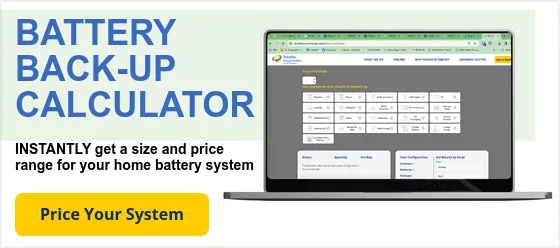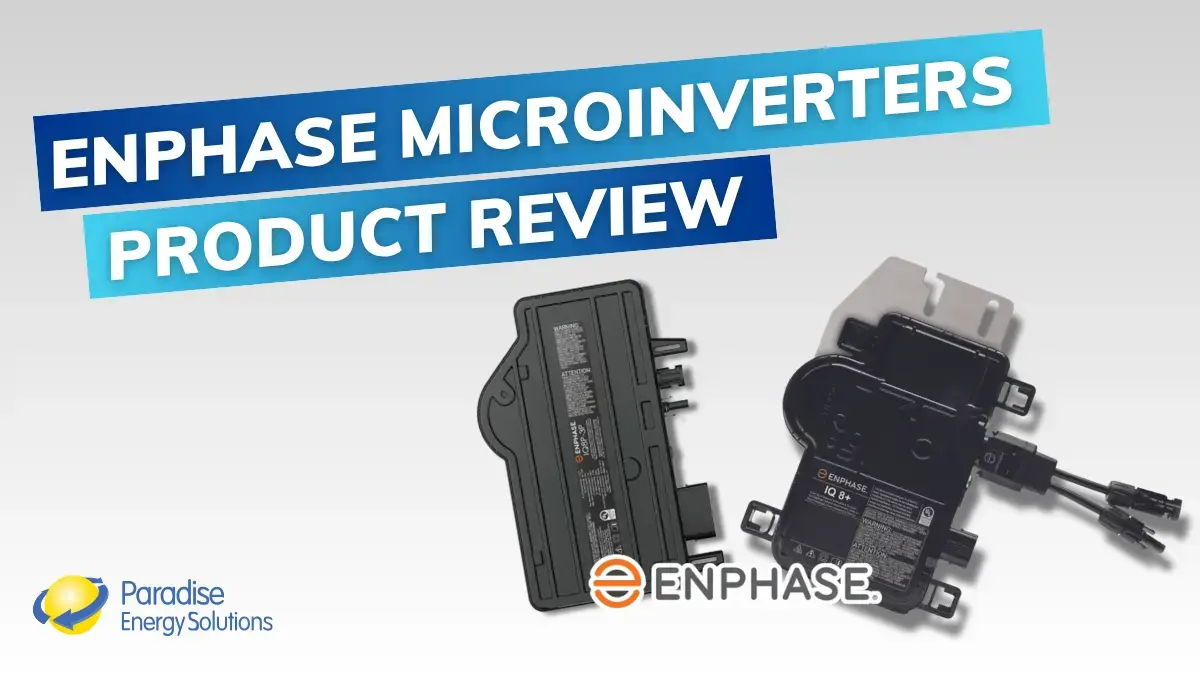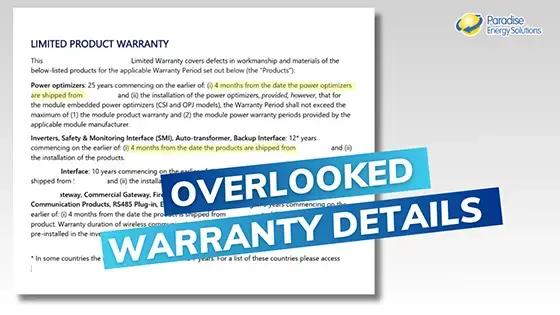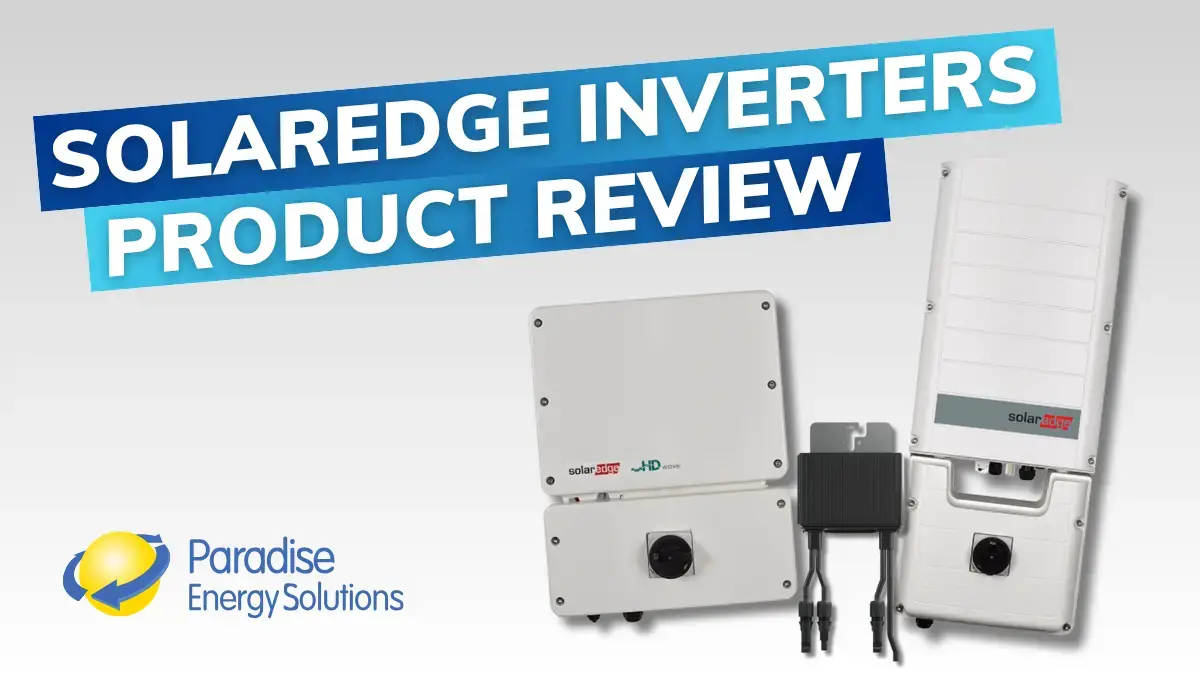It’s a snowy Saturday afternoon. You’ve caught up on all your household duties and errands. It’s finally time to sit down on your couch in front of the television for some well-earned R&R.
A few minutes later, your TV screen fades to black. The lights flicker and then turn off. The familiar hum of your heat pump and refrigerator goes silent.
The lights have gone out, and the grid has gone down. If you own a solar system or are considering solar, you may think that your solar panels will continue to produce electricity. But unfortunately, as long as you’re hooked up to the electric grid, your system shuts down, and you have no electricity. Unless you have a battery-backed solar system.
How much storage does an average battery backup system have, and what devices can you run when the lights go out?
Despite advances in battery technology, backing up your solar system could still cost you a lot of money. To get the biggest bang for your buck, you’ll want to identify the devices that are the most important to keep running. These essential appliances are known as your home’s essential electricity needs.
What Are Your Essential Loads?
Your essential electric loads are important equipment and devices you want to keep running when you lose electricity. These could be things like medical equipment, lights, or appliances.
If you have a solar system that produces enough electricity to power your entire home, why do you have to select specific items to back up? A common misconception is that you’ll be able to store enough energy to power your entire home during a power outage in batteries. Unfortunately, the number of batteries required to do this would cost much more than most homeowners can spend. That’s why many opt for just backing up the essentials.
Once selected, those loads will be connected to a sub-panel, which will be connected to your battery bank. When the grid goes down and your solar system is disconnected, your sub-panel will switch on, and you’ll be able to draw stored solar energy from your batteries to power just these essential loads.

Determining the Essential Loads for Your Home
Consider a few different things when planning your battery backup system. First, you will have to prioritize the devices or appliances in your home based on how essential they are during a power outage.
These could include keeping on some of the lights in certain rooms, running the fridge so your groceries don’t expire, or providing power to a space heater for a few hours. You then need to determine the peak power requirements of those critical loads. This is the maximum amount of energy these loads will use simultaneously.
- Maximum Running Wattage
- Starting Wattage
 The maximum running wattage is how much electricity is needed to power a device while you’re using it. To get the most accurate value, look at the device itself. Most appliances will have the maximum running wattage on them. If yours does not, check online for the specific model or get a general idea with this chart.
The maximum running wattage is how much electricity is needed to power a device while you’re using it. To get the most accurate value, look at the device itself. Most appliances will have the maximum running wattage on them. If yours does not, check online for the specific model or get a general idea with this chart.
Certain devices also take extra energy to power up on top of the running wattage. Items with an inductive motor will require additional power the first few seconds they are running. This includes:
- Refrigerator
- Washing Machine
- Electric Stoves
- Sump Pump
- Water Well Pump
- Window and Central AC
- Heat Pump
For some devices like a washing machine or stove, you can be sure you only start the device up a certain number of times. However, devices like a refrigerator or air conditioner may start and stop several times during your power outage, thus using more of your batteries’ stored energy.
Like the device’s maximum running wattage, you should be able to find its specific starting wattage on the device itself. This figure should be added to the device’s maximum running wattage to get a full picture of the device’s electrical requirements.
Here are some items that do not typically require additional wattage to start:
- Light bulbs
- Toasters
- Microwaves
- Coffee Makers
- Security Systems
The Peak Power Requirements
Before choosing how many batteries you need or finalizing your list of critical loads, you will need to define the peak power requirements of your critical loads. This is the maximum amount of electricity you will use at one time. You can do this by adding up two sets of values: all the maximum running wattages for your critical loads and all their starting wattages. If a device or appliance does not have a starting wattage (like a light bulb), use its maximum running wattage instead.
Here’s an example:
|
Critical Load |
Maximum Running Wattage |
Starting Wattage |
|
5x 60-Watt Light bulbs |
300 watts |
300 watts (no starting wattage) |
|
Refrigerator |
780 watts |
2,000 watts |
|
Television |
100 watts |
100 watts (no starting wattage) |
|
Laptop Charger |
60 watts |
60 watts (no starting wattage) |
|
One Window AC Unit |
1,500 watts |
2,000 watts |
|
2,740 watts |
4,460 watts |
In this example, the peak power requirements would be 4,460 watts or 4.5 kW. That is the most electricity your critical loads will require at one time. Compare this number to your battery’s maximum discharge power and your inverter’s backup power rating. If either of these ratings is lower than your peak power requirements, you will need to install more battery storage and/or a larger inverter, or you will need to remove items from your essential loads list. For many 9.8 kWh batteries, the maximum power is 5.0 kW. That means the battery would support this list of important loads.
Time
There is another important factor in all of this: time. The amount of time you would like your loads to run will determine how many batteries you will need. This is difficult to estimate because the longer the electricity goes out, the more energy you will use. However, batteries are still expensive, and you don’t want to spend your hard-earned money on more than you need.
You can estimate how long your battery will power your essential loads by dividing your battery’s capacity by the total running wattage of your list. For the example above, you will get about 3.5 hours (9.8 kWh / 2,740 watts). That means you’ll be able to power all the items on the above list with one 9.8 kWh battery for roughly 3.5 hours.
If you’re interested in installing batteries for your home, click the button below. We can talk about your essential load list, how long you’d like to power your home, and what kind of battery backup system is right for you.
If you’re not ready for a quote, use our battery calculator to get an idea of what a battery system will cost. The calculator allows you to select your essential loads and returns the number of batteries and inverters you will need, along with an estimated cost.













